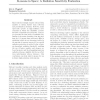Free Online Productivity Tools
i2Speak
i2Symbol
i2OCR
iTex2Img
iWeb2Print
iWeb2Shot
i2Type
iPdf2Split
iPdf2Merge
i2Bopomofo
i2Arabic
i2Style
i2Image
i2PDF
iLatex2Rtf
Sci2ools
86
Voted
ICML
2009
IEEE
2009
IEEE
K-means in space: a radiation sensitivity evaluation
Spacecraft increasingly employ onboard data analysis to inform further data collection and prioritization decisions. However, many spacecraft operate in high-radiation environments in which the reliability of dataintensive computation is not known. This paper presents the first study of radiation sensitivity for k-means clustering. Our key findings are 1) k-means data structures differ in sensitivity, which is not determined solely by the amount of memory exposed; 2) no special radiation protection is needed below a dataset-dependent radiation threshold, enabling the use of faster, smaller, and cheaper onboard memory; and 3) subsampling improves radiation tolerance slightly, but the use of kdtrees unfortunately reduces tolerance. Our conclusions can help tailor k-means for use in future high-radiation environments.
ICML 2009 | Improves Radiation Tolerance | K-means Data Structures | Machine Learning | Radiation Sensitivity |
| Added | 17 Nov 2009 |
| Updated | 17 Nov 2009 |
| Type | Conference |
| Year | 2009 |
| Where | ICML |
| Authors | Kiri L. Wagstaff, Benjamin Bornstein |
Comments (0)

